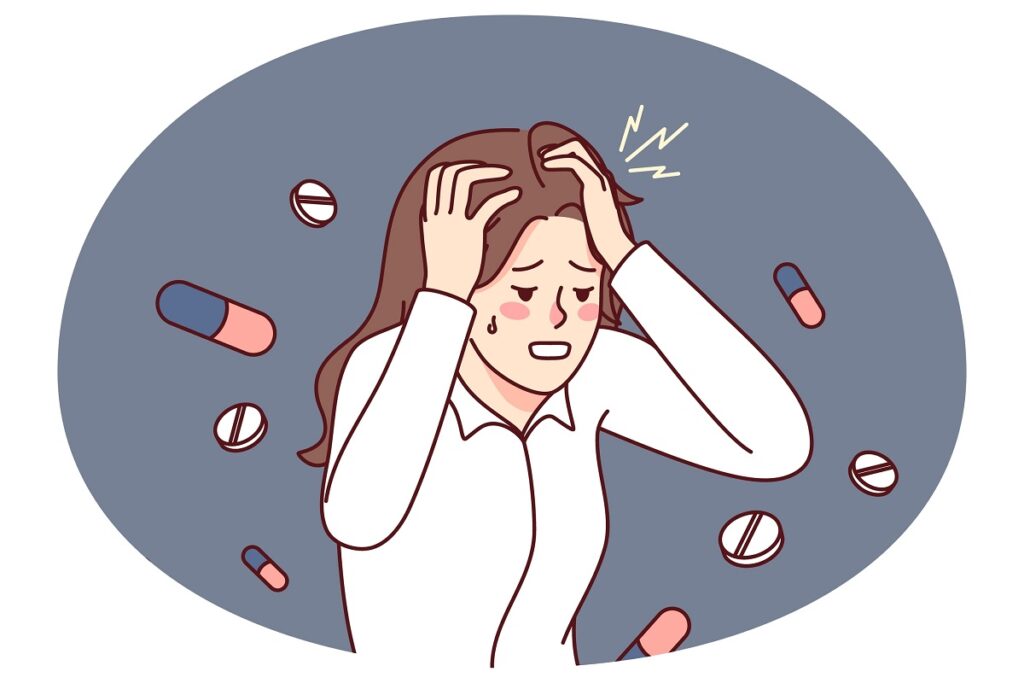

Migraine is a common neurological disorder that affects 1 in 5 Australians. The most common symptoms of a migraine attack are moderate to severe headache, feeling sick (nausea), and sensitivity to light, noise, or smells. Common triggers for migraine attacks include stress, alcohol, caffeine, lack of sleep, hormonal changes, and more.
For more information about migraine symptoms, different types of migraine, and migraine causes and triggers, read our previous article.
There is no cure for migraine, but there are many different treatment options. Medication options include drugs taken during a migraine attack to ease the symptoms (acute treatments), and medications taken regularly to help prevent migraine attacks (preventative / prophylactic treatments). Non-medication treatment options include complementary therapies, neuromodulation, migraine management plans, and lifestyle adjustments.
In this article, we list current medication options and discuss the most recent drugs to be approved for migraine treatment.
For more information about non-medication treatments, read our previous article.
The following medications may be taken when a migraine attack happens to reduce symptoms. These include over-the-counter and prescription-only drugs.
|
Drug Type |
Examples |
|
Simple analgesics |
· Paracetamol · Aspirin · Ibuprofen · Naproxen · Diclofenac |
|
Triptans |
· Sumatriptan (tablet, injection, or nasal spray) · Rizatriptan (tablet or wafer) · Zolmitriptan · Eletriptan · Naratriptan |
|
Antiemetics (anti-nausea drugs) |
· Metoclopramide (tablet or injection) · Prochlorperazine (tablet, injection, or suppository) |
Using acute treatments for migraine too often can worsen headaches. This is known as medication overuse headache. The chances of this happening depend on the type of drug and how often it is being used. To reduce the risk, experts recommend acute treatments be restricted as follows:
Note, opioids, including codeine, are not recommended for migraine because they are generally not very effective and have a high risk of causing medication overuse headache.
The following medications may be prescribed by a doctor to help prevent migraine attacks. These are usually indicated for people living with chronic migraine and those who have frequent headaches. They can also help with recovery from medication overuse headache.
Drug Type | Examples |
Anticonvulsants | · Topiramate · Valproate |
Beta-blockers | · Propranolol · Metoprolol |
Antidepressants | · Amitriptyline · Venlafaxine |
Others | · Botulinum toxin (Botox) (injection) · Pizotifen |
Since 2018, there have been several new drugs approved for the treatment of migraine within Australia. These new drugs belong to two new classes of migraine medications:
Calcitonin gene-related peptide (CGRP) is a small protein that plays a major role in migraine. High levels have been measured in blood samples from people diagnosed with migraine and other head pain disorders.
During a migraine attack, increased levels of CGRP are released by the trigeminal nerves, which are the major nerves in the head that relay sensory information between the face and brain.
The released CGRP has several actions, including:
The new migraine drugs block CGRP from doing this, either by binding directly to CGRP, or by binding to its receptors.
CGRP monoclonal antibodies are the first drugs to be developed specifically for the prevention of migraine. They inactivate CGRP by directly binding to it or to its receptors.
They are administered by injection or infusion. Only a neurologist can start a patient on these medications.
The CGRP monoclonal antibodies approved for use in Australia are:
Drug | Dosage | Approved | PBS Listed? |
Erenumab | Monthly injection | July 2018 | No |
Galcanezumab | Monthly injection | May 2019 | Yes |
Fremanezumab | Injection every 1 or 3 months | November 2019 | Yes |
Eptinezumab | 30-minute infusion every 3 months | June 2021 | Yes |
*PBS = Pharmaceutical Benefits Scheme.
Gepants are the newest class of medications to be developed for acute treatment of migraine symptoms. They do so by blocking CGRP receptors. They are available as tablets to be taken by mouth.
Studies suggest that gepants do not cause medication overuse headache. Therefore, they could potentially be used for migraine prevention.
The only gepant currently approved for use in Australia is rimegepant (approved August 2023; not listed on the PBS).
The following gepants are not yet available in Australia but have been approved in the USA: atogepant, ubrogepant, zavegepant.
We are currently recruiting participants for a clinical trial involving a recently approved drug for migraine treatment and prevention.
Looking for treatment options for migraine that don’t involve drugs? We are also running a clinical trial involving a new surgical treatment for chronic migraine.
Please note, recruitment is currently paused for this study and may not reopen.
Websites:
1. Headache Australia. https://headacheaustralia.org.au/
a. “Migraine Treatment Options”. https://headacheaustralia.org.au/migraine/treatment-options/
2. Migraine Australia. https://www.migraine.org.au/
a. “CGRP Therapies”. https://www.migraine.org.au/cgrp
3. The Migraine Trust: https://migrainetrust.org/
a. “Calcitonin Gene-Related Peptide (CGRP) monoclonal antibodies”. https://migrainetrust.org/live-with-migraine/healthcare/treatments/calcitonin-gene-related-peptide-monoclonal-antibodies/
b. “Gepants”. https://migrainetrust.org/live-with-migraine/healthcare/treatments/gepants/
4. Edwards L. “Migraine medications struggle to get PBS listing”. The New England Times; 5 June 2023. https://www.netimes.com.au/2023/06/05/migraine-medications-struggle-to-get-pbs-listing/
5. Schwedt TJ, Garza I. “Acute treatment of migraine in adults”. UpToDate. 2023 Oct. https://www.uptodate.com/contents/acute-treatment-of-migraine-in-adults
Journal Articles:
6. Aguilar-Shea AL, Membrilla Md JA, Diaz-de-Teran J. “Migraine review for general practice”. Aten Primaria. 2022; 54(2): 102208. https://www.ncbi.nlm.nih.gov/pmc/articles/PMC8605054/
7. Fischer MA, Jan A. “Medication-Overuse Headache”. [Updated 2023 Jun 26]. In: StatPearls [Internet]. Treasure Island (FL): StatPearls Publishing; 2023. https://www.ncbi.nlm.nih.gov/books/NBK538150/
8. Jenkins B. “Migraine management”. Aust Prescr. 2020; 43: 148-51. https://doi.org/10.18773/austprescr.2020.047
9. Mohanty D, Lippmann S. “CGRP Inhibitors for Migraine”. Innov Clin Neurosci. 2020; 17(4-6): 39-40. https://www.ncbi.nlm.nih.gov/pmc/articles/PMC7413335/
10. Moriarty M, Mallick-Searle T, Barch CA, Oas K. “Monoclonal Antibodies to CGRP or Its Receptor for Migraine Prevention”. J Nurse Pract. 2019; 15(10): 717-724. https://doi.org/10.1016/j.nurpra.2019.07.009
11. Ray JC, Kapoor M, Stark RJ, Wang SJ, Bendtsen L, Matharu M, Hutton EJ. “Calcitonin gene related peptide in migraine: current therapeutics, future implications and potential off-target effects”. J Neurol Neurosurg Psychiatry. 2021; 92(12): 1325-1334. https://doi.org/10.1136/jnnp-2020-324674
12. Ray JC, Macindoe C, Ginevra M, Hutton EJ. “The state of migraine: An update on current and emerging treatments”. Aust J Gen Pract. 2021; 50(12): 915-921. https://www1.racgp.org.au/ajgp/2021/december/the-state-of-migrain
View our currently recruiting studies:
Register your interest for future studies:
© Genesis Research Services, 2023